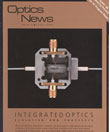
February, 1988 Issue
- Recent advances in LiNbO3 integrated optics
- The role of silicon in integrated optics
- Integrated optics using lll-V compound semiconductor materials
- Ti:LiNbO3 Integrated optics for high-speed fiber communication
- Integrated optical sensors in lithium niobate
- Integrated optical processing and computing
- Pilot-line production of Ti:LiNbO3 integrated optical devices
- Manufacturing of lithium niobate integrated optic devices
- Semiconductor standards: A lesson for optics?
- Browse all Issues
Feature Articles
Recent advances in LiNbO3 integrated optics
Over the past several years, LiNbO3 based integrated optics devices have moved from the device designer's laboratory into the more nearly real world of systems experiments. A few types of devices have even become commercially available in small quantities. Other articles in this issue will discuss the place of LiNbO3 in experimental communication, sensing and computing systems, and the emergence of LiNbO3 manufacturing and foundry services. This article discusses some of the theoretical and practical advances that are making LiNbO3 a viable material.
by Janet Lehr JackelThe role of silicon in integrated optics
Silicon is the mainstay of the modern microelectronics industry, so it is only natural to consider its potential for use in integrated optical or optoelectronic circuits. This idea is especially attractive from a commercial point of view, since high purity crystalline silicon is already available at low cost, and since there is already a well established processing technology for silicon.
by Dennis G. HallTi:LiNbO3 Integrated optics for high-speed fiber communication
Name how you would like to alter the characteristics of an optical wave and chances are you can design a Ti:LiNbO3 integrated optic device to do attributes by themselves, however, do not guarantee unequivocal commercial success. Indeed, most existing fiber communication systems are basic in nature and tend to evolve smoothly from one generation to the next.
by Steven K. KorotkyIntegrated optical sensors in lithium niobate
Optical guided-wave devices are of interest as sensors because the active device can be small and nonperturbing. An integrated optical modulator can form a compact electric field detector and has no long, electrically-conductive leads that can be perturbing. A channel waveguide device, with small dimensions and closely spaced electrodes, is much more sensitive than a bulk device and is therefore more useful where small physical parameters are to be detected. Lithium niobate (LiNbO3) is a suitable material in which to form a sensor; it has large electro-optic coefficients, which make it responsive to small fields, and low optical loss.
by Catherine H. BulmerIntegrated optical processing and computing
Over the past several years, numerous guided wave and/or integrated optical components have been proposed (and, in many cases, experimentally demonstrated) for the implementation of a wide range of optical information processing, optical signal processing, and optical computing functions.
by Armand R. Tanguay, Jr.Pilot-line production of Ti:LiNbO3 integrated optical devices
During the past three years, the level of effort in Ti: LiNbO3 integrated optical (IO) devices has changed from one or two devices being fabricated at a time in R&D laboratories throughout the world to 10s-100s of devices being fabricated at a time by commercial companies. Standard, multifunction, and custom IO products are available from Crystal Technology Inc. (CTI) as well as other companies. Recently the CTI Integrated Optic Foundry has been made available for customers to design their own IO device and have them fabricated at the Foundry. During this developmental period, the differences between fabricating one device and manufacturing many devices have been evaluated. This paper reviews the basic fabrication steps and discusses the issues that become important when volume manufacturing is considered.
by R. A. BeckerManufacturing of lithium niobate integrated optic devices
Integrated optical devices are now commercially available from several sources. Several companies are offering integrated optical circuit products for sale. This indicates that many of the initial difficulties have been overcome. Commercialization activities for a merchant market are currently underway at Amphenol Products, Crystal Technology Inc. (CTI), Barr & Stroud, and British Telecom—DuPont (BT-D). Product announcements have appeared for both phase modulators, amplitude modulators, and an optical switch. These and other more advanced devices are now commercially available with pigtailed optical fibers.
by G. J. Sellers and S. SriramSemiconductor standards: A lesson for optics?
This month we will again draw on material published by the National Bureau of Standards, in this case the NBS Research Report for August 1987. The report deals with NBS efforts in the area of linewidth standards for the semiconductor industry. Some of the problems in this area can be contrasted with the optics industry problem of inspection for surface beauty defects, in particular, scratches. A key factor to keep in mind is the relative economic importance of the semiconductor industry compared to the optical industry.
by Robert E. Parks

![Manual probe system with needles for test of semiconductor on silicon wafer. [A. Morozov / Getty]](https://opnmedia.blob.core.windows.net/$web/opn/media/images/articles/2025/1125/departments/202511-cover-web.jpg?ext=.jpg)
![Researcher Clara Saraceno in the lab. [Image by Carsten Behler Photography]](https://opnmedia.blob.core.windows.net/$web/opn/media/images/articles/2025/1025/departments/202510-cover-web.jpg?ext=.jpg)
